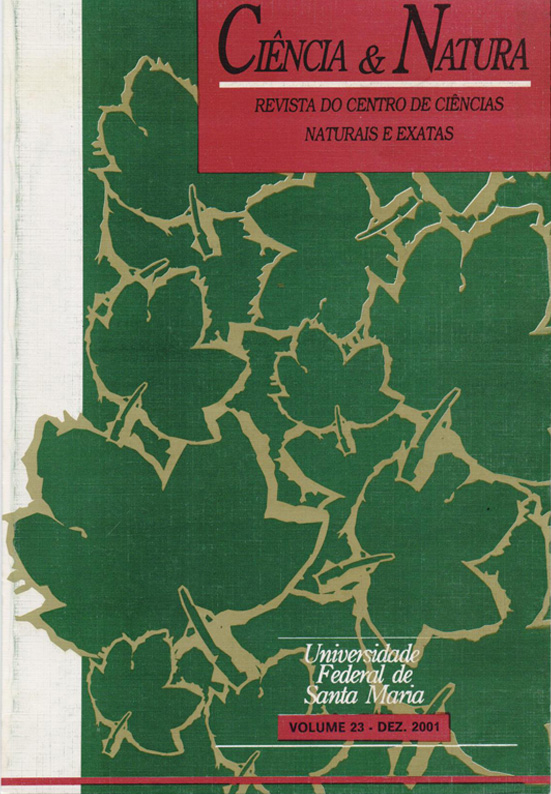Interferência de Trichoderma spp. no crescimento do feijoeiro (Phaseolus vulgaris cv. carioca)
DOI:
https://doi.org/10.5902/2179460X27125Resumo
O objetivo deste trabalho foi o de avaliar a interferência causada pelo fungo Trichoderma spp. no crescimento do feijoeiro (Phaseolus vulgaris cv. Carioca). Para isso, utiliza-se três isolados J10, I1 e TSM1 de Trichoderma spp. que foram inoculados em arroz com casca e deixamos em câmara climática por quatro dias. Misturaram-se 40g desse inóculo em solo autoclavado (vasos com capacidade de 700g de solo) antes da semeadura (quatro repetições e quatro plantas por vaso). Quinze dias após a semeadura, mediu-se a altura de plantas, deste ao ápice até o colo. Constatou-se diferenças significativas no crescimento das plântulas de feijão.
Downloads
Referências
ASSIS, T.C. Controle biológico de microrganismos presentes em sementes de mamona (Ricinus comunis). Fitopatologia Brasileira, v.19, Suplemento, p. 269, agosto de 1994.
BETTIOL, W., GHINI, R. Controle biológico. Capo 36. In: BERGAMIN FILHO, A., KIMATI, H., AMORIN, L. Manual de fitopatologia. 3. ed. São Paulo: Agronômica Ceres, 1995. 919 p. 2v. V1.
FERNANDEZ-LARREA, O.V. Microorganismos entomopatógenos y antagonistas. Posibilidades de produción. C. de La Habana : INISAV, 1995. 15 p. (Boletim Técnico, 1).
LUZ, W.C. da. Controle biológico das doenças na espermosfera. Cap. 3. In: BETTIOL, W. (org.) Controle biológico de doenças de plantas. Jaguariúna : EMBRAPA-CNPDA, 1991.(EMBRAPA-CNPDA. Documentos, 15).
MELO, I.S. de. Potencialidades de utilização de Trichoderma spp. no controle biológico de doenças de plantas. Cap. 9. In: BETTIOL, W. (org.) Controle biológico de doenças de plantas. Jaguariúna: EMBRAPA-CNPDA, 1991. (EMBRAPA-CNPDA. Documentos, 15).
MENEZES, M. Avaliação de espécies de Trichoderma no tratamento de sementes de feijão e do solo, visando o controle de Macrophomina phaseolina. Fitopatologia Brasileira, v.17, n.2, p. 159, agosto de 1992.
PIMENTEL, C.P.V., CORAL, F.J., LUCON, C.M.M., FARIA, R.G. Efeito de Trichoderma viride sobre Phytophthora spp. Fitopatologia Brasileira, v.19, Suplemento, p. 301, agosto de 1994.
PORFÍRIO-SILVA, Z., HOMECHIN, M. Pseudomonas spp. e Trichoderma spp.: promotores de crescimento de plântulas de tomateiro. Fitopatologia Brasileira, v.17, n.2, p. 217, agosto de 1992.
RAMIREZ, I.S., LÓPEZ, M.O., GARCíA, D., et al. Trichoderma harzianum (cepa A 34): un biopreparado de amplio espectro para micopatologías dei tomate y dei pimiento. C. de La Habana: INISAV, 1995. 36 p. (CID-INISAV Boletín Técnico, 3).
ROSA, C.R.E, SILVA, A.C.F. Avaliação de isolados de Trichoderma spp. visando o controle de Sclerotinia sclerotiorum. In: JORNADA ACADÊMICA INTEGRADA, 13. Santa Maria - RS, 1998. Anais … Universidade Federal de Santa Maria, 1998.
SILVA, A.C.F. da. Uso da radiação gama para obtenção de mutantes de Trichoderma harzianum Rifai e Trichoderma viride Pers.: Fr. com capacidade melhorada no controle ao Sclerotinia sclerotiorum (Lib.) de Bary. Tese de Doutorado. (Centro de Energia Nuclear na Agricultura - USP) Piracicaba: Universidade de São Paulo, 1997.
SILVA, A.C.F. da, MELO, I.S. Influência da luz no crescimento micelial e produção de esporos em diferentes linhagens de Trichoderma spp. In: REUNIÃO SOBRE CONTROLE BIOLÓGICO DE DOENÇAS DE PLANTAS, 1. Anais ... Piracicaba, Fundação Cargil ,1986.
Downloads
Publicado
Como Citar
Edição
Seção
Licença
Para acessar a DECLARAÇÃO DE ORIGINALIDADE E EXCLUSIVIDADE E CESSÃO DE DIREITOS AUTORAIS clique aqui.
Diretrizes Éticas para Publicação de Revistas
A revista Ciência e Natura está empenhada em garantir a ética na publicação e na qualidade dos artigos.
A conformidade com padrões de comportamento ético é, portanto, esperada de todas as partes envolvidas: Autores, Editores e Revisores.
Em particular,
Autores: Os Autores devem apresentar uma discussão objetiva sobre a importância do trabalho de pesquisa, bem como detalhes e referências suficientes para permitir que outros reproduzam as experiências. Declarações fraudulentas ou intencionalmente incorretas constituem comportamento antiético e são inaceitáveis. Artigos de Revisão também devem ser objetivos, abrangentes e relatos precisos do estado da arte. Os Autores devem assegurar que seu trabalho é uma obra totalmente original, e se o trabalho e / ou palavras de outros têm sido utilizadas, isso tem sido devidamente reconhecido. O plágio em todas as suas formas constitui um comportamento publicitário não ético e é inaceitável. Submeter o mesmo manuscrito a mais de um jornal simultaneamente constitui um comportamento publicitário não ético e é inaceitável. Os Autores não devem submeter artigos que descrevam essencialmente a mesma pesquisa a mais de uma revista. O Autor correspondente deve garantir que haja um consenso total de todos os Co-autores na aprovação da versão final do artigo e sua submissão para publicação.
Editores: Os Editores devem avaliar manuscritos exclusivamente com base no seu mérito acadêmico. Um Editor não deve usar informações não publicadas na própria pesquisa do Editor sem o consentimento expresso por escrito do Autor. Os Editores devem tomar medidas de resposta razoável quando tiverem sido apresentadas queixas éticas relativas a um manuscrito submetido ou publicado.
Revisores: Todos os manuscritos recebidos para revisão devem ser tratados como documentos confidenciais. As informações ou ideias privilegiadas obtidas através da análise por pares devem ser mantidas confidenciais e não utilizadas para vantagens pessoais. As revisões devem ser conduzidas objetivamente e as observações devem ser formuladas claramente com argumentos de apoio, de modo que os Autores possam usá-los para melhorar o artigo. Qualquer Revisor selecionado que se sinta desqualificado para rever a pesquisa relatada em um manuscrito ou sabe que sua rápida revisão será impossível deve notificar o Editor e desculpar-se do processo de revisão. Os Revisores não devem considerar manuscritos nos quais tenham conflitos de interesse resultantes de relacionamentos ou conexões competitivas, colaborativas ou outras conexões com qualquer dos autores, empresas ou instituições conectadas aos documentos.






